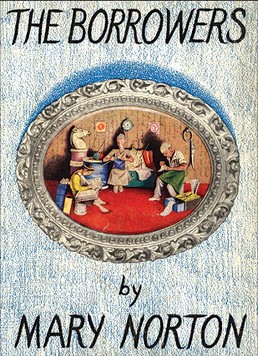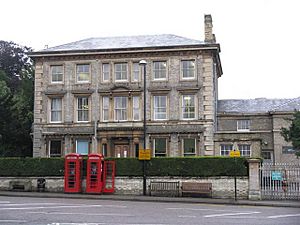The Borrowers facts for kids
|
Stanley cover of first edition
|
|
| Author | Mary Norton |
|---|---|
| Illustrator | Diana L. Stanley (first) Beth and Joe Krush (US) |
| Country | United Kingdom |
| Language | English |
| Series | The Borrowers |
| Genre | Children's fantasy novel |
| Publisher | J. M. Dent (first); Harcourt, Brace (US) |
|
Publication date
|
1952 (first) 1953 (US) |
| Media type | Print (hardcover) |
| Pages | 159pp (first); 180pp (US) |
| OCLC | 7557055 |
| LC Class | PZ7.N8248 Bd 1952 |
| Followed by | The Borrowers Afield |
The Borrowers is a children's fantasy novel by the English author Mary Norton, published by Dent in 1952. It features a family of tiny people who live secretly in the walls and floors of an English house and "borrow" from the big people in order to survive. The Borrowers also refers to the series of five novels including The Borrowers and four sequels that feature the same family after they leave "their" house.
The Borrowers won the 1952 Carnegie Medal from the Library Association, recognising the year's outstanding children's book by a British author. In the 70th anniversary celebration of the medal in 2007 it was named one of the top ten Medal-winning works, selected by a panel to compose the ballot for a public election of the all-time favourite.
Harcourt, Brace and Company published it in the U.S. in 1953 with illustrations by Beth and Joe Krush. It was also published in four parts, with illustrations by Erik Blegvad, during the summer of 1953 (June, July, August, September) in Woman's Day magazine. There have been several adaptations of The Borrowers in television and film.
Series
All five Borrowers novels feature the Clock family; Pod, Homily and Arrietty. In the first book they live in a house reportedly based on The Cedars where Norton was raised. The sequels are titled alliteratively and alphabetically: The Borrowers Afield (1955), The Borrowers Afloat (1959), The Borrowers Aloft (1961), and The Borrowers Avenged (1982). All were originally published by J. M. Dent in hardcover editions. Puffin Books published a 700-page trade paperback omnibus edition in 1983, The Complete Borrowers Stories with a short introduction by Norton.
The primary cause of trouble and source of plot is the interaction between the minuscule Borrowers and the "human beans", whether the human motives are kind or selfish. The main character is teenage Arrietty, who often begins relationships with Big People that have chaotic effects on the lives of herself and her family, causing her parents to react with fear and worry.
As a result of Arrietty's curiosity and friendships with Big People, her family are forced to move their home several times from one place to another, making their lives more adventurous than the average Borrower would prefer. After escaping from their home under the kitchen floorboards of an old English manor they finally settle down in the home of a caretaker on the grounds of an old church.
Along the way, they meet more characters: other Borrowers, including a young man around Arrietty's age who lives outdoors and whose only memory of his family is the descriptive phrase, "Dreadful Spiller", which he uses as a name (introduced in The Borrowers Afield), the Harpsichord family who are relatives of the Clock family, and Peregrine ("Peagreen") Overmantel; and also Big People such as Mild Eye the gypsy, Tom Goodenough, the gardener's son, and Miss Menzies, a sweet but overly helpful woman.
The short, separate book Poor Stainless (1966) was revised as a novelette and re-published posthumously with a short author's note in 1994. The narrative, told by Homily to Arrietty, occurs before the first of the full-length Borrower novels, and concerns a small adventure Stainless has when he gets lost. (Like most Borrower names "borrowed" from human objects, Stainless is named after items in the kitchen cutlery drawer.)
Characters
- Borrowers
- Arrietty Clock: An adventurous and curious fourteen-year-old Borrower. She knows how to read, owns a collection of pocket-sized books, and is fascinated with "human beans" after meeting The Boy. She is also the only Borrower educated enough to comprehend that the Borrowers may be dying out. In later books, her interactions with humans frequently cause concern for her parents.
- Pod Clock: Arrietty's father. A talented Borrower and a shoemaker who creates button boots out of beads and old kid gloves. He is cautious, but not opposed to new ideas, and a quick inventor and improviser.
- Homily Clock: Arrietty's mother, a nervous woman who likes her tidy domestic world and can't bear the thought of hardship or discomfort. Nevertheless she often shows fortitude in difficult or dangerous situations, though she complains constantly through them. She is extremely proud of Arrietty and encourages her to educate herself through reading.
- Hendreary Clock: Arrietty's uncle and Pod's brother. He and his family were one of many Borrower families who used to live in the house, but they were eventually forced to leave after Hendreary was "seen." When he finally appears in later books, he is a weary, dispirited man who allows his wife to make all their important decisions.
- Lupy (Rain-Pipe Harpsichord) Clock – Uncle Hendreary's wife and a distant relation to Homily. Homily dislikes Lupy for putting on airs because she was once a member of the prestigious Harpsichord family, though she envies Lupy's elegance and refinement. She has three sons from a previous marriage and a stepdaughter, Eggletina. She is prissy, bossy, and dominating.
- Eggletina Clock: Hendreary's daughter from his first marriage. Eggletina's family attempted to protect her by lying about the Big House and failed to inform her that her father had been "seen." Unaware of the dangers, Eggletina was also unaware that the "human beans" had brought in a cat. She wandered out to explore and was presumed eaten, though in the second book, Arrietty learns that she is still alive, and that she is a thin, shy girl.
- The Overmantels: A family of Borrowers who lived on the drawing room mantelpiece, they were snobbish and given to airs, but Homily pities them because they were forced to live on nothing but breakfast food and often went hungry. The Overmantels were one of many Borrower families that emigrated once there were too few humans to sustain them.
- The Rain-Pipes: A family of Borrowers who lived in a drainpipe, they were considered lower-class because their home was prone to flooding, frequently wiping out all their possessions and leaving them destitute. Aunt Lupy was born a Rain-Pipe until she married into the Harpsichord family. Their fate is unknown but presumably they, too, moved away.
- The Harpsichords: Another family of Borrowers who lived in the drawing room wainscot where a harpsichord used to stand. They mixed with the Over mantels and were likewise prone to putting on airs. Lupy married into the Harpsichord family and had three sons before presumably being left a widow. The Harpsichords had lovely manners but likewise suffered from lack of food. They too emigrated once the drawing room stopped being used.
- The Bell-Pulls: Homily's parents. It is implied that they died of natural causes between Homily's marriage and Arrietty's early childhood, as Arrietty cannot remember them.
- The Rainbarrels, the Linen-Presses, the Boot-Racks, the Stove-Pipes, the Hon. John Studdingtons: Former Borrower families who once lived in the house. All moved away after their respective areas of the house ceased to be used. (In the case of the Hon. John Studdingtons, they lived behind a portrait of The Boy's great-uncle.)
- Big People
- Kate: A "wild, untidy, self-willed little girl" of 10 years. Kate learns of the Borrowers in the first book. In later books, a slightly older Kate makes a habit of trying to find out more clues of their existence.
- The Boy: A ten-year-old boy sent to recover from an illness at the country home of his great-aunt near Leighton Buzzard. As he was raised in India, he has difficulty reading in English, and is often thoughtful and quiet, a trait the servants interpret as "sly" and untrustworthy. He befriends Arrietty and her family.
- Mrs May/Aunt May: Kate's elderly aunt who tells Kate the story of the Borrowers. The Boy was her brother, and as a young woman she heard his tales of the Borrowers and spent a good deal of time seeking the truth of them. In subsequent books, an adult May inherits a cottage reputed to be the home of more Borrowers.
- Great-Aunt Sophy: The Boy's elderly great-aunt, she is an invalid who never comes downstairs. The servants (and the Borrowers) refer to her as "Her." She spends most of her time in bed, and Pod sometimes comes to visit her. She believes that the Borrowers are an hallucination.
- Mrs Driver: The housekeeper and cook. With Great-Aunt Sophy confined to bed, Mrs Driver is in charge of the whole house. She is grumpy, bossy, gossipy, and resents being required to look after The Boy, whom she dislikes on sight.
- Crampfurl: The gardener and Mrs Driver's crony. He, too, dislikes The Boy based solely on Driver's suspicions.
- Rosa Pickhatchet: A former housemaid who quit after seeing a Borrower.



